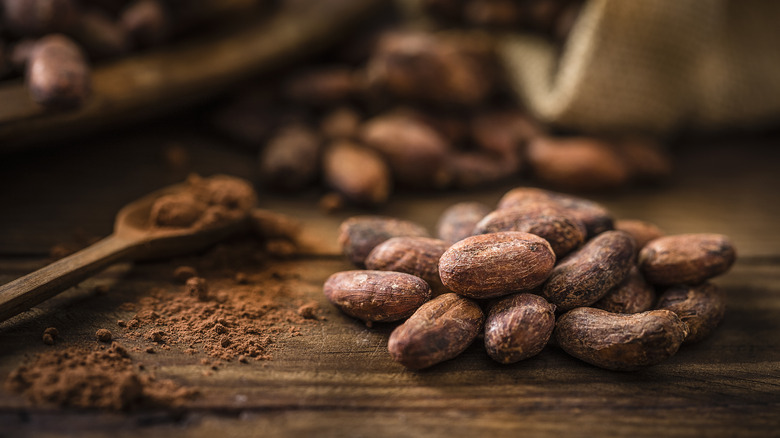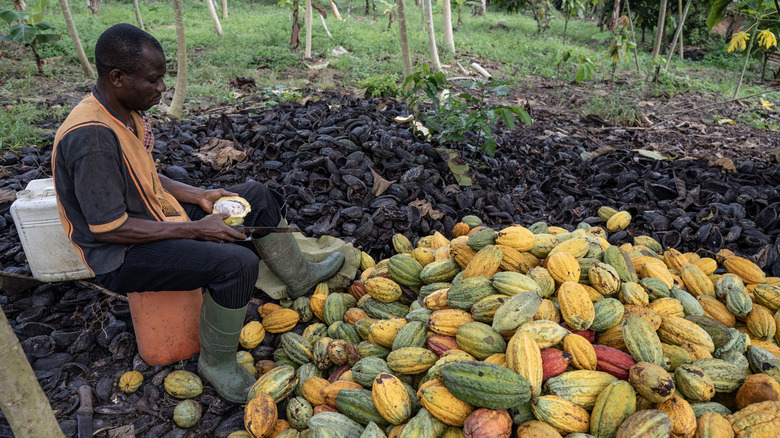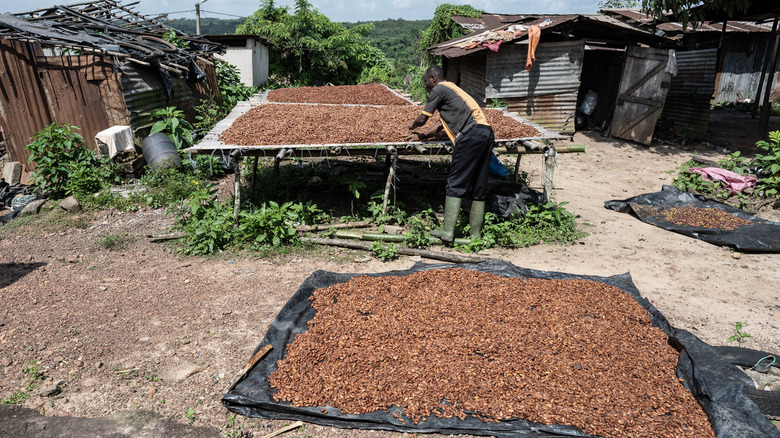The Country That Supplies Most Of The World's Cocoa
Picture this: You're peeling back the plastic on your favorite chocolate bar, ready to indulge in a sweet treat you've craved all day. But have you ever stopped, taken a look at that chocolate, and wondered how it got from the plant to your hands? It's all thanks to the production and harvesting of cocoa, most of which comes from the Ivory Coast in Africa (also known as Côte d'Ivoire).
In fact, three of the world's top five cocoa-producing countries are in Africa. After Ivory Coast, cocoa production mostly comes from Ghana, Indonesia, Ecuador, and Cameroon, with Ivory Coast and Ghana producing two-thirds of the world's cocoa. The process starts with the cacao plant, a tree whose seeds house cocoa beans. It takes up to six months for a cacao plant to be harvest-ready, and once it is, those beans are stripped and turned into that delicious, smooth dessert we know as chocolate. But if you're a big-time chocolate lover, you might be disappointed to learn that cocoa prices skyrocketed in 2023 after heavy rainfall in West Africa caused damage concerns among a large number of the plants. The 2023 shortage resulted in about 25% fewer cocoa crops, and the shortage will likely carry into 2024.
Ivory Coast produces more cocoa than any other country
Ivory Coast produces over two million metric tons of cocoa each year. For the most part, crops are harvested during two parts of the year: October through February, then again from May through August. Certain countries in Africa boast an optimal climate for cacao plants; they need consistently warm temperatures to grow — somewhere between 65 degrees Fahrenheit and 90 degrees Fahrenheit — so only countries within about 20 degrees longitude of the equator have warm enough climates suitable for this plant. Plus, cacao plants need plenty of moisture in the air, as well as frequent rainfall to produce the best crop, all of which are found in Ivory Coast's climate.
Without these specific weather conditions, cacao can't grow well, which explains why only certain countries can produce the plant. In Ivory Coast, the rainy season runs from April to October; according to Brittanica, the rainfall totals around 45-60 inches in just a six-month span (for comparison, the average rainfall for the whole year in the US contiguous states was just 28 inches in all of 2022, per the National Centers for Environmental Information).
Rising temperatures could impact Ivory Coast's cocoa production
While chocolate might not seem like a notable treat, the harsh reality is that it could become harder to find — and more expensive — as the years go on. Ivory Coast's average temperatures are slowly increasing, but the rainfall production isn't matching up. In the next 30 years, the country will see its average temperature increase by about four degrees Fahrenheit. While that doesn't seem like a lot, it's enough to alter the plants' growth. Since more moisture will evaporate from the cacao plants in higher temperatures and rainfall measurements are staying the same, the plants could dry out and affect production.
It's also estimated that Ivory Coast farmers will have to shift their crops to higher elevations in order to account for the temperature difference. Ideal conditions are currently an average of 575 feet above sea level, but by 2050, those ideal conditions will be found at an average of 1,550 feet above sea level. The result could be fewer crops and higher prices, with the potential for chocolate to eventually become extinct.


